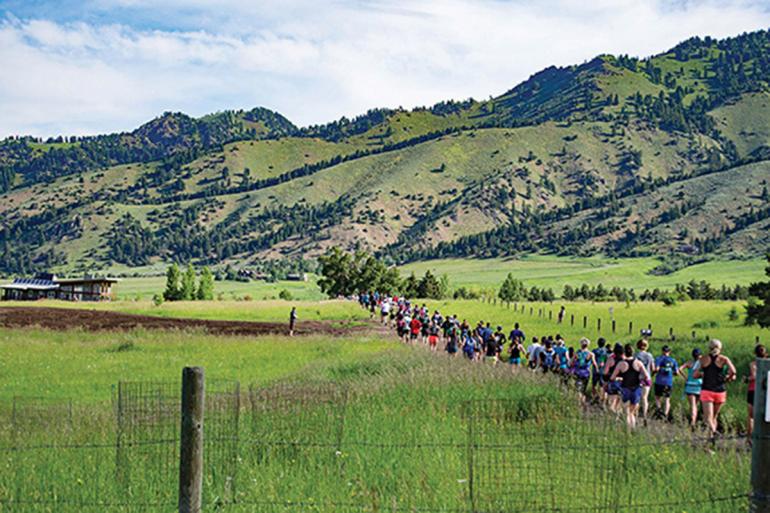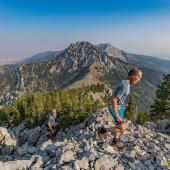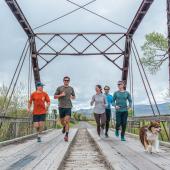Air It Out
Take your running to the trails.
So, this is the year that you’re going to start trail running. As a lover of all Gallatin Valley trails, I’m here to help, with some assistance from a panel of expert trail enthusiasts.
First off, leave your ego at home. If you’re new to trail running, your road 5k or 10k personal bests become irrelevant. Each trail is unique in its demands and your total time on any trail might take twice as long as a road run of the same length.
Trail races are predominantly longer distances and most of the races we’ll be talking about are over 10k. That’s part of the game. Walking the steep sections is a thing, whether you’re in the lead pack or out on your first excursion.
In Bozeman, unpredictable weather is a major challenge. Late March through early April can be a tough go if we’ve had a good snow year. “Look for south-facing trails that don’t get as much snow; they’ll open up earlier,” says Casey Jermyn, owner of Bozeman Running Company and head coach of the Bozeman Hawks’ formidable cross-country team. “A lot of people don’t realize how early the Lewis and Clark Caverns are ready to go. We do a race there in mid-April and it’s been really great.” Before diving straight into the race scene, set some reasonable pre-season mileage goals. “As an entry-level trail runner, that’s going to be around 10-15k and you can work up from there,” he says. “Bozeman is great for having soft terrain to run on prior to trail season. Peets Hill, the Linear trails, and the GVLT running trails all provide great scenery and keep you off of the pavement.” Casey says that your distance should mimic the trail runs you plan on doing. So, for entry-level running, “having a base of five to six miles would be good.”
He continues: “The big difference between running on the road and trail running is that you shouldn’t focus on the distance.” Take your road goals and plans, he says, which concentrate on distance and pace, and “throw them out the window. They no longer exist. I’d much rather see you focus on minutes. Everything with trail running can be so different. Your pace will be a lot slower.” He also points out that there is less aid provided at trail races, so you have to prepare for that. “Understanding that aspect and being more self-supportive needs to be a priority,” he cautions.
Being prepared to be self-sufficient on trails includes having your hydration method figured out, bear spray if needed, GPS if applicable, fuel for your body, TP, sunscreen, insect repellent, and the appropriate clothing—not to mention the all-important trail shoes on your feet. Dewey Peacock, longtime personal trainer and frequent top race finisher, comments on the importance of coming into spring strong. By building your base with cross-country or backcountry skiing and spending time in the gym, he says, you can better prepare for the rigors of the upcoming uphill. Then, he says, “Coming into the transition, when you can actually get onto the trails, most people can get race-ready with only two designated trail runs a week.” One, he explains, would be a longer weekend run, “where the goal should be to try and extend the time on your feet and experience as much elevation change as you can.” Not to be overlooked are gear, nutrition, and hydration.
“Understanding how that backpack is going to fit or how your shoes are working when you have time to play around with your gear—that’s critical to figure out at least a month before your first big race,” Dewey points out.
Bridger Orthopedic physical therapist Jeff Sabatka is new to Bozeman, but he hit the trails running, so to speak, winning the Foothills 14k in his Montana trail-racing debut. To remain injury-free, Jeff relies on cross-training extensively, only running one to three times per week. Skiing, biking, swimming, and focused strength work all lend to his impressive results. Jeff prioritizes proximal hip stabilization as a goal for going into the season strong. Think lateral work, with bands and monster walks. “I’ll put a band on at home while I’m cooking dinner, or do double-leg squats with a band as a warm-up to get my hips moving,” he says. “The more you can do strengthening on one leg, the better. Single-leg curtsey lunges, step-ups, and jump lunges are all great gym exercises.” Later, when you can get outside, Jeff suggests hill repeats, uphill skipping, and high-knee drives to continue to strengthen the legs before race season begins.
Internationally respected (and feared) trail runner Mike Foote is also the co-founder of the Rut in Big Sky. This three-day event is indisputably the most wicked collection of trail runs in our area, or perhaps anywhere. The 50k attracts international entrants, boasting over 10,000 feet of seriously technical terrain. The 28k, 11k, and 1k vertical are badass as well, and all should be given careful consideration before committing to them as one’s first trail-race endeavor. With sign-up in January and race start in September, Mike knows that a lot can happen (or not happen!) in eight months. “I’m a big believer that people overestimate what they can do in the short term yet underestimate what they can do in the long term,” he explains. “With a race eight months away, it’s important to ease into the training and find grace in the process. Getting too excited too soon will lead to burnout at just the wrong time.” He loves the timing of the Rut—Labor Day Weekend—“because it gives us Montanans time to play in the alpine after the snow melts and get in our big days in July and August.” Mike advises choosing a couple smaller races earlier in the season as stepping stones. “It’s a good way to add variety to the training and get you mentally prepared for the big day,” he says.
So there you have it: a brief intro to the Bozeman trail scene, which I’m sure will exceed your expectations. I’m also sure that you will drop trou, with or without TP, in places you never thought would see your backside, and that you’ll leave more than a little blood in the Bridgers. Enjoy!













